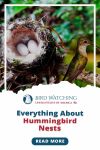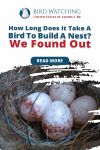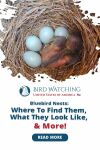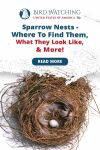
What’s This Post About?
Hummingbirds belong to the Trochilidae family of birds. These exotically colored creatures seem to be concentrated in existence, only in the region of South America. However, the ruby-throated hummingbird is found in North America, between Nova Scotia, Canada, and Florida in the US.
Hummingbird nests are a fine, compact wonder of craftsmanship. With carefully intertwined twigs and plant fibers, these tiny habitats are an awe-inspiring vision. It can take anywhere between 5 to 7 days to build a nest for these majestic birds.
Weighing approximately the same as half a walnut, these miniature works of art have much in common. Continue reading to find out how!
The Nesting Season

There are about 350 species of hummingbirds, most of which do not breed. The remaining eight species of hummingbirds regularly nest throughout the US and Canada.
Oddly enough, hummingbirds nest during the winter season. More specifically, in December through May. The males migrate towards the feeding grounds during this time.
The females arrive about two weeks after. Mating occurs within the next three days of their arrival, and then the females take their leave. The next job at hand for the female hummingbirds is to build the nest and lay their eggs. They lay 1 to 2 eggs every season.
At this point, the male hummingbirds take their leave and never again come into contact with the female counterparts ever again. It would not be wrong to conclude that hummingbirds don’t mate for life.
Fun Fact
Hummingbirds live only 3 to 5 years in the wild. However, there have been recorded instances of hummingbirds living up to a maximum of 12 to 14 years in captivity.
The Females Are Resilient

Interestingly, the responsibility of parenting falls solely on the female hummingbirds. After mating, the female hummingbirds gather all that they may need to build their nests. At the same time, the males go back to doing what they do best, looking for the next female hummingbird to mate with.
The male hummingbirds have only one purpose throughout their lives. They guard the flowers and feeders against other male birds in an attempt to impress the female birds and convince them to mate.
Once they mate and finish building their nests, the female birds lay about two eggs in the nest. They are in charge of keeping the eggs warm and taking care of the little broods once they hatch. The males play no part in the upbringing of the nestlings.
The nestlings remain in the nest for about three weeks while the female hummingbird feeds and cares for them. After this, the nestlings are old enough to leave the nest, and the female hummingbird begins preparing for the next breeding.
Fun Fact
Hummingbirds are anti-social birds.
They compete for food and resources. Male hummingbirds are known for their aerial combat against other males present while they guard the flowers. The mating season is extra competitive. During this season, the fight to dominate can get gruesome. The males might even use their long sharp beaks to pierce the opponent's throat. Wild!
Choosing the Nests’ Location

Hummingbird nests are usually hard to find. If you live in the vicinity of hummingbirds, chances are, you probably walked right past one without even noticing.
Owing to their small size, you may find it difficult to spot hummingbird nests unless you specifically search them. They are also artfully camouflaged and may look just like a part of the branch.
Hummingbirds mostly nest in thick bushes, vines, seed walks, ferns, or flowering plants. One of their favorite locations is also conifer trees due to their height and sturdy branches.
One thing to note is that they nest, mostly at a significant height, to prevent an attack from predators. These nests can be as high as 1 to 90 feet above the ground. Hummingbirds never nest on the ground.
They mostly form their nests in between thick leaves from all sides, avoid being in sight, and look for sufficient overhead protection from the rain. This is one reason why these nests are almost impossible to spot.
How to Find A Hummingbird Nest?

Although it’s a little tricky, we have one way you can find a hummingbird nest in your location.
Firstly, move to an area considerably rich in fresh nectar flowers and a few of some of their most preferred trees. Sit in a slightly elevated seat and relax. Patiently observe the natural surroundings.
If you spot a hummingbird, follow the trail carefully. It might just lead you right to the nest. If you lose it, wait for it to come back and notice the location from where it flew out.
You may also want to consider the fact that the hummingbird may intentionally be leading you astray. Therefore, there is only a 50% chance this might work. Don’t be disheartened, though. Remain persistent, and you may eventually find one.
Remember to make sure you leave the nest alone once you have found it. Do not tamper with the habitat or consistently revisit for the sake of curiosity. You may subconsciously cause damage to the nest or attract unwanted attention.
What Are Nests Made Of?
Hummingbirds use several conventional tools to form their nests, most of which comprise intertwined plant twigs and tiny leaves.
Other substances of hairy or fuzzy textures are also used, such as willow, cotton wool, witch hazel, and plant fibers of cattails.
There is also one particular element of hummingbird nests that makes them super strong, and this secret element is spider silk. Wrapping spider silk around the nest gives them extra strength and makes them resilient.
Once they’ve gathered all their elements, hummingbirds work by either forming the floor of the nest first and then layer up to build the walls on all four sides.
In other instances, they build a flat nest and then push down the middle to form the floor. Fascinating, isn’t it?
Please Remember This!
Another thing to remember is that each hummingbird nest is used for about 35 to 36 days after which the nestlings are old enough to be on their own.
Once the baby birds leave the nest, some female hummingbirds also reuse their nests for the second breeding season. This proves exactly how strong these nests are!
The Man-Made Nest Ruse
One major misconception about hummingbirds is that setting up birdhouses for hummingbirds might attract them to your backyard.
So let us tell you this before you buy that birdhouse you’ve had your eye on. Do not click on ‘Add To Cart’.
Hummingbirds will never use artificial or human-made houses as living spaces. These birds are used to living away from the public eye. Therefore, they build their nests in seclusion and would not opt for a habitat so flamboyant and out in the open.
In fact, none of the wild bird species choose to live in birdhouses. Birds like to conjure up their specific nests to hide their hatchlings from predators. So don’t buy those birdhouses. They’re useless.
However, you can buy a birdfeeder for your hummingbirds. Hummingbirds love to eat. They eat very often throughout the day.
Leave some sugar water out on your birdfeeder for the hummingbirds to attract them to your backyard.
Pro-Tip
If you do plan on leaving out food for the hummingbirds in your feeder, make sure to keep it clean. You can change the feeding bowl and clean the structure with 9 parts water and 1 part bleach. Use this once a week to keep away mold or salmonella in your feeder.
Protect the Nest at All Costs

Hummingbirds may be one of the fastest birds in all species. However, they are still at a threat by a large number of predators waiting to attack.
Reptiles are their worst enemy. Large snakes and lizards are quick to gobble up the nestlings before they even hatch.
The birds are also susceptible to getting caught by invertebrates such as spiders in their long sticky, woven webs. The Praying mantis is one other dangerous predator of hummingbirds.
They might even fall prey to some of their kind. Predator birds such as Roadrunners, Kestrels, Shrikes, or even Corvids might kill them.
Climate change is also one factor. As the earth’s climate changes, hummingbirds find it difficult to find food. Their migratory patterns change, and this, in turn, affects their population strength.
However, the most threatening predators to hummingbirds are humans. Most nests are destroyed when we trim the hedges of our bushes or cut down trees.
People often also continue to revisit any nests they have spotted and thus, attract attention towards the nest that these hummingbirds tirelessly try to conceal.
Remember, our affection for wildlife should not interfere with the efforts and lives of these exotic birds. An important lesson to take from this is to let the nest be if spotted. Please do not go back to the nest, nor tell anyone else about its location. You may kill them.
How to Make Your Backyard the New Hummingbird Eatery?
While urbanization continues to destroy a perfectly good habitat for these beautiful tiny creatures, you can always rebuild it in your very own backyard.
One way to do this is to sow the right seeds and plant the right flowers. Most flowers that hummingbirds use to feed off require the possession of certain characteristics in color, shape, and type of nectar. Some of these characteristics are as follows.
The flowers should provide a large amount of nectar, with a significant amount of sugar content. This constitutes about 26% of sugar, which is double that of what we find in soft drinks.
The flowers should preferably have orange or red petals so that the hummingbird from a distance can spot them.
Most of these plants also have their flowers drooping or hanging downwards so that birds that hover, like the hummingbird, can easily extract nectar.
Their stems are usually also long and tubular so that these birds can use their long beaks and tongues to suck out their juicy goodness.
Some of the hummingbirds’ favorite flowers are:
- Bee Balm
- Cardinal Flower
- Trumpet Creeper
- Coral Honeysuckle
- Columbine
Alternatively, you can leave some sugar water out on your bird feeder for the hummingbirds as well.
Fun Fact
Did you know that hummingbirds eat a lot? They have some of the highest metabolisms in the species and need to eat several times a day to live. They can eat up to half their body weight in nectar and eat every 10 to 15 mins!
Keep Reading!
There is no doubt that hummingbird nests are an architectural wonder. Their intricate structure and clever camouflage set them apart from several other habitats in their species.
Though sturdy and beautiful, these nests are extremely sensitive to any tampering or predator attack. Hummingbirds, in general, have a lifespan of a maximum of 5 years.
Hence, refrain from unintentionally harming hummingbird nests if you ever come across them in your neighborhood park or your backyard. These tiny, gorgeous birds are at a threat of being extinct.
It is, therefore, safe to say that hummingbirds are intelligent creatures, the females are resilient, and the males are fierce. The power dynamic between both genders is fascinating and particularly evident in how they breed and parent.
So, let’s feed them, protect them and marvel at their grandeur. For more information, consider reading our amazing post about top hummingbird feeders:
Best Bird Feeders for Hummingbirds: The 13 Top Rated Feeders
Are you a hummingbird lover? Make this adorable little bird visit your garden by adding one of these top-rated feeders to your backyard.

By David A. Swanson
Bird Watching USA
My name is David and I'm the the founder of Bird Watching USA! I started Bird Watching with My father-in-law many years ago, and I've become an addict to watching these beautiful creatures. I've learnt so much over about bird watching over the years that I want to share with the world everything I know about them!

David A. Swanson
Bird Watching USA
My name is David and I'm the the founder of Bird Watching USA! I started Bird Watching with My father-in-law many years ago, and I've become an addict to watching these beautiful creatures. I've learnt so much over about bird watching over the years that I want to share with the world everything I know about them!









